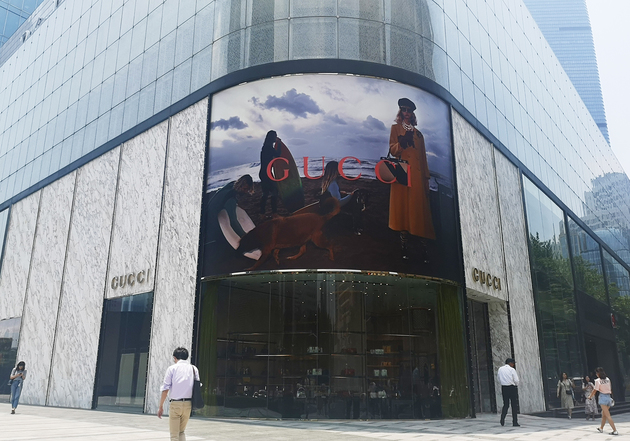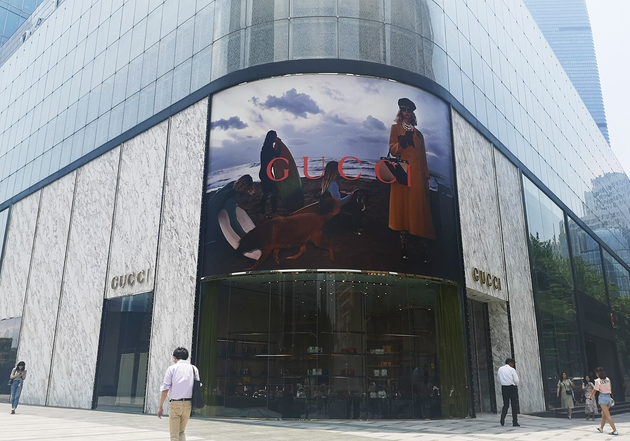
On March 20, luxury fashion giant Kering, the parent company of Gucci, experienced a sharp decline in stock prices shortly after opening, with the drop reaching a staggering 15%—the largest single-day decline in its history. This sudden “flash crash” sent shockwaves throughout the market.
Industry experts attribute this stock price performance to the unexpected plummet in Gucci’s sales in the Asia-Pacific region. It is projected that Gucci’s sales for the first quarter of 2024 will decline by nearly 20% year-on-year. As a perennial powerhouse in the luxury goods sector, how did Gucci suddenly find itself struggling to move merchandise? Not long ago, Gucci even followed the price hike trend, with some popular handbag models saw an increase of over a thousand dollars.

File Photo
However, these price increases failed to rescue Gucci’s sales. Consumers seemed hesitant to make purchases, and Gucci’s lackluster performance even dragged down Kering Group’s overall financial results. In a market filled with uncertainties and fierce competition, can Gucci turn the tide under the guidance of its new designer?
“The disappointing actual performance and future uncertainties are the primary reasons behind the stock price decline,” noted luxury goods expert Zhou Ting during an interview with NBD.
As a global leader in luxury brands, Kering Group not only owns Gucci but also manages a portfolio of other renowned fashion, leather goods, and jewelry brands, including Saint Laurent, Bottega Veneta, Balenciaga, and Boucheron. However, Zhou Ting believes that the group’s heavy reliance on a single brand—Gucci—poses risks. “As Gucci goes, so does Kering. Other brands within the group do not wield enough influence to significantly impact Kering’s overall performance.”
Interestingly, earlier this month, Gucci implemented a series of price increases. When NBD inquired about this as consumers, Gucci’s customer service representatives explained that the brand consistently adjusts prices annually. This year’s price adjustments occurred on March 1. For instance, the original price of the Gucci “Marmont” bag at 8700 yuan has now risen to 9800 yuan, representing a substantial increase of over 12%.
While products saw price hikes, the stock price simultaneously plummeted. Why did Gucci suddenly struggle to attract buyers?
According to Zhou Ting, the collapse of the brand’s image is a major factor. “Luxury brands are further stratifying. While LV and Chanel actively compete for the top luxury brand position alongside Hermès, Gucci is gradually withdrawing from the ultra-premium luxury brand camp. The second reason for Gucci’s sales decline lies in its lack of innovative products. Consumer preferences have diversified, and product innovation has become a core competitive capability for luxury brands. Unfortunately, Gucci hasn’t delivered in this area in recent years.”
Simultaneously, Zhou Ting points out that Gucci has made “a series of failed market strategies.” The lack of selectivity in customer demographics and sales channels, coupled with an unclear brand positioning, has led to a significant customer exodus, discouraging new customers from choosing Gucci.
In early 2024, Gucci launched a robust marketing campaign. In January and February, the brand unveiled a new men’s and women’s fashion collection created by its newly appointed creative director, Sabato De Sarno, during Milan Fashion Week.
China remains a critical market for Gucci. Notably, the Chengdu IFS store was once crowned Gucci’s global single-store “sales champion.” From March 11 to 17, the brand’s flagship offline space, “Gucci Ankorah Red,” simultaneously opened in six Chinese cities: Shanghai, Chengdu, Beijing, and Shenzhen. This event marked the largest-scale activity for the brand in China since Sabato De Sarno’s appointment and served as the designer’s debut showcase in the country.
From the widely recognized “Tiffany Blue” and “Hermès Orange” to the current “Gucci Ankorah Red,” iconic brand colors leave an indelible impression on consumers, establishing immediate visual recognition—a crucial step in successful brand marketing.
Opinions within the industry vary. Zhou Ting believes that Gucci’s current designs may not resonate with individualistic Chinese consumers. Thus, whether “Gucci Ankorah Red” can ignite Gucci’s resurgence remains to be seen.


 川公网安备 51019002001991号
川公网安备 51019002001991号





